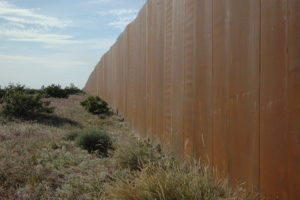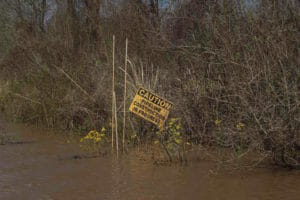Standing Rock Tribe Calls for Action in Face of Impending Pipeline Construction
The fight over the Dakota Access pipeline is reaching a boiling point as peaceful demonstrators seek to halt imminent drilling. A trash pile at Oceti Sakowin camp. (Donald Kaufman / Truthdig)
A trash pile at Oceti Sakowin camp. (Donald Kaufman / Truthdig)
The Sacred Stone #NoDAPL camp. (Donald Kaufman / Truthdig)
“It’s a ghost town.”
This is how Truthdig contributor Donald Kaufman described the Standing Rock Indian Reservation on Wednesday in North Dakota after Tuesday’s news that the U.S. Army Corps of Engineers officially granted easement for the construction of the Dakota Access pipeline following Donald Trump’s executive order to expedite the project.
“Trump’s Army Corps approved the death of our river,” summed up Chase Iron Eyes, an indigenous activist at the head of the #NoDAPL movement.
The U.S. Army Corps of Engineers has granted an easement allowing the Dakota Access Pipeline to cross under the Missouri River north of the Standing Rock Sioux Reservation, paving the way for construction of the final 1.5 miles of the more than 1,700-mile pipeline.
In doing so, the Army cut short its environmental impact assessment and the public comment period associated with it. …
In a letter to Congress announcing the decision, Deputy Assistant Secretary of the Army Paul Cramer cited the president’s memorandum, saying that “consistent with the direction” in the memo, his agency would “waive its policy to wait 14 days after Congressional notification before granting an easement.”
He wrote that the Army would officially grant the easement as soon as Wednesday afternoon, at which point the company building the pipeline, Energy Transfer Partners, would be able to begin construction.
Morale at the Standing Rock Indian Reservation and the surrounding encampments is low, according to Kaufman.
“Everyone is pretty upset here with yesterday’s news,” he reported from North Dakota.
But the fight isn’t over, even though a faction of the movement, including Standing Rock Sioux tribal Chairman Dave Archambault II, has urged people to go home. “Veterans and other tribes are expected to come to Standing Rock,” Kaufman said. “It looks like many will be here beginning next week.”
In a video statement posted to Facebook Tuesday, Iron Eyes put out a call for more pipeline opponents, who call themselves water protectors.
“This is an emergency situation,” Iron Eyes said. “If you are self-sufficient, if you are disciplined, you are among a couple thousand people who are already coming back, including three contingents of United States veterans.”
The Standing Rock Sioux tribe is also taking the fight to the courts.
“The Obama administration correctly found that the Tribe’s treaty rights needed to be acknowledged and protected, and that the easement should not be granted without further review and consideration of alternative crossing locations,” Jan Hasselman, the lead attorney for the tribe, said as part of a Tuesday press release. “Trump’s reversal of that decision continues a historic pattern of broken promises to Indian Tribes and unlawful violation of Treaty rights. They will be held accountable in court.”
As for Oceti Sakowin Camp, the main encampment used to house water protectors?
In the past few weeks, the atmosphere at Standing Rock has changed dramatically — in part due to President Trump’s memorandums calling for the continued construction of the DAPL and the Keystone XL Pipeline. Since Trump signed this presidential memorandum several days into his presidency, water protectors have scrambled to resume opposition to the proposed pipeline.
Oceti Sakowin, the encampment used to house many of the water protectors from out of state, is in the midst of a massive transition. Last week, the U.S. Army Corps ordered the evacuation of the camp. In the days since the order, water protectors and officials in Morton County have been hauling debris out of the camp.
“We want to stress that we are cleaning the camps, not clearing them,” the Standing Rock Sioux tribe said in a statement posted to Facebook Saturday. “We have not asked for law enforcement to assist in clearing camps and in fact have repeatedly told them there will be no forcible removal.”
A trash pile at Oceti Sakowin camp. (Donald Kaufman / Truthdig)
Now, many water protectors are trying to figure out where to set up shop. According to The Bismarck Tribune, the Cheyenne River Sioux tribe is leasing out some private land near Oceti Sakowin.
But after another temporary camp was erected near the proposed DAPL construction site, North Dakota law enforcement intervened last Wednesday. A total of 76 people, including Iron Eyes, were arrested. The Bismarck Tribune reported:
The short-lived encampment, known as the “Last Child Camp,” was composed of several teepees atop a hill across from the main Oceti Sakowin camp. According to a post from Dallas Goldtooth, a campaign organizer of the Indigenous Environmental Network, police told Oceti Sakowin camp security they would not be raiding that encampment on U.S. Army Corps of Engineers land. …
As recently as Sunday, ongoing dialogue between all parties, including camp leaders from the various protester camps, resulted in agreements to start cleaning up the camps, to have protesters leave the area and for steps by law enforcement to help de-escalate the situation.
“We don’t seek violence, we don’t even seek to be aggressive,” Iron Eyes said in his video statement, referring to his arrest. “And we don’t call out for that.”
Kaufman noted that many of the incoming veterans will be housed at Sacred Stone, another #NoDAPL encampment.
Despite the intense preparation currently underway in North Dakota, the Trump administration seems to be paying little attention to the situation. During a press conference late Tuesday, Trump commented on the opposition to the pipeline.
“I haven’t had one call,” he remarked. “I don’t even think it was controversial.”
However, many #NoDAPL actions have popped up across the nation in response to the Trump administration’s green light on pipeline construction.
The city of Seattle made headlines Tuesday for divesting billions from Wells Fargo, which has provided economic support for the pipeline construction.
And demonstrations broke out around the country Wednesday as part of Standing Rock’s “Worldwide Call to Action,” an “international day of emergency actions to disrupt business as usual and unleash a global intersectional resistance to fossil fuels and fascism.”
The situation at Standing Rock is likely to grow increasingly tense, as water protectors flock once again to North Dakota to “stop the black snake” that is the oil pipeline.
“If you go [to North Dakota],” the Sacred Stone camp wrote in its call to action, “expect police violence, mass arrests, felony charges for just about anything, abuse while in custody, targeted persecution and racial profiling while driving around the area, etc.”
But for veteran water protectors like Iron Eyes, any risk is worth opposing the Dakota Access pipeline — or as he recently labeled it, the “focal point of Trump’s tyranny.”
Your support matters…Independent journalism is under threat and overshadowed by heavily funded mainstream media.
You can help level the playing field. Become a member.
Your tax-deductible contribution keeps us digging beneath the headlines to give you thought-provoking, investigative reporting and analysis that unearths what's really happening- without compromise.
Give today to support our courageous, independent journalists.


You need to be a supporter to comment.
There are currently no responses to this article.
Be the first to respond.